The UEFA Champions League is back, and it brought us some brilliant tactical matchups. In the first round of group B, Bayern Munich welcomed Red Star Belgrade in the match that reminded football fans of the classic clashes of those two teams from the second half of the 20th century.
Even though the Serbs are once again in European elite competition, they didn’t manage to steal the show at Allianz Arena and get away with a piece of loot. Niko Kovač’s men dominated the pitch throughout the whole match and deservedly won on their home turf, with the only issue to realise their opportunities. This tactical analysis will show you how the Germans controlled the play on the field and how they got into their chances.
Lineups
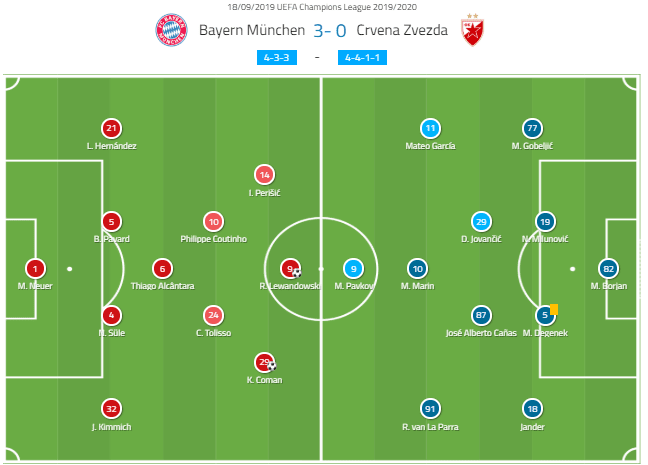
Kovač set his team in a 4-2-3-1 formation with a lot of shape transformations throughout the match, which lead them to create free space all over the pitch. The midfield was held by Corentin Tolisso, Thiago Alcântara and Phillipe Coutinho, with the huge support of Joshua Kimmich who often inverted to play as a fourth midfielder. The main attacking forces were the two wings embodied in Ivan Perišić and Kingsley Coman with their target-man Robert Lewandowski on the top of the lineup.
Vladan Milojević went into the game with his usual 4-2-3-1 tactics that were mostly oriented to defending their goal. Nemanja Milunović and Miloš Degenek pulled the strings in the defensive line and commanded the block of their team with José Alberto Cañas doing the same in the midfield line. Milan Pavkov was the lonely striker, and he had help from their first star Marko Marin, along with Mateo Garcia on one flank, and Rajiv van la Para on the other.
Creating the room against the dense block
Since Red Star sat tight in their low block – that was transformed in their usual 4-4-2 shape – it was clear that Bayern will be the one controlling the situation and dictating the moves in this match. From the beginning of the match, they’ve struggled in finding the loopholes in opposition’s structure but they managed to create space with good midfield rotations.
The keys to their plan were the midfielders alongside with Kimmich who frequently inverted himself to create numerical superiority for his team in one zone of the pitch. He communicated with Thiago and Tolisso pretty well and often changed places with them so they could open the opponent for the break-through pass.
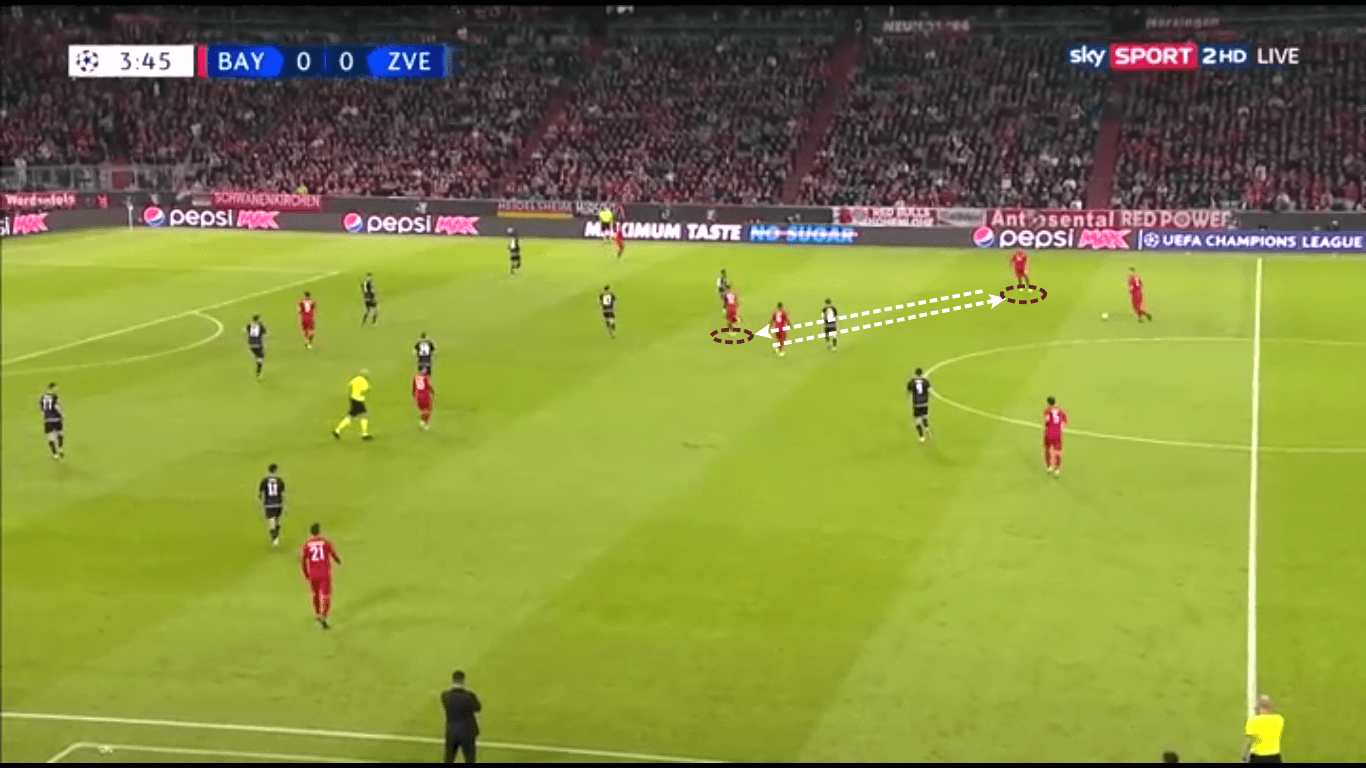
As we can see in the picture, the full-back comes inwards and drags the player with him while one of the midfielders fills the space that left empty and gets the ball in it. Those rotations often disrupted the Red Star’s block and confused them in order which player guards which opponent so Bayern got some space to manoeuvre in.
Kimmich’s motions also cleared the passing lanes for his wide team-mates. Van la Para who played in his side had a lot of troubles trying to “read” the play and closing the play through Crvena Zvezda’s lines so he often found himself in the no man’s land which lead the Bavarians to play through his side of the pitch.
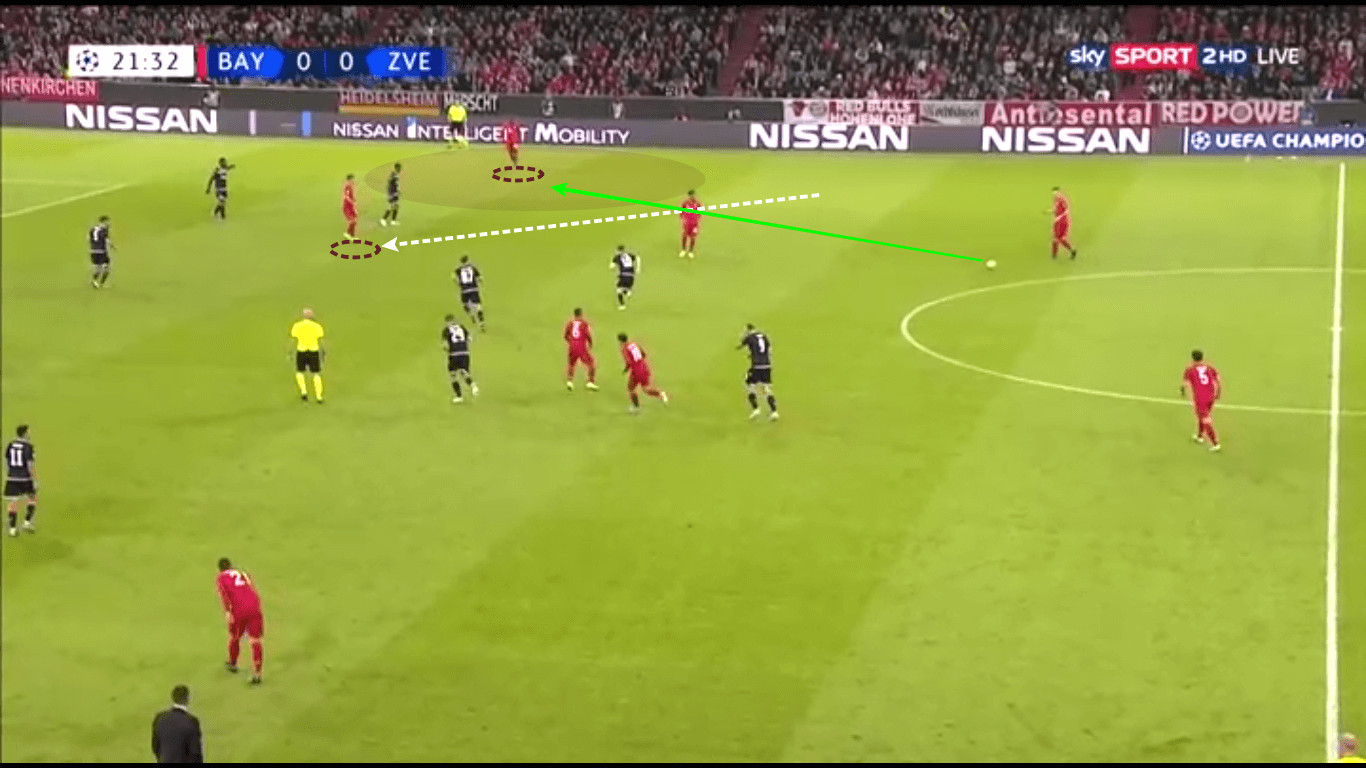
The Bayern’s polyvalent right-back cut inwards throughout the whole match and opened the space for his wingers to get into the “1v1” situations or to attempt early crosses from the flanks. His team was very dangerous out of those, and the German international surely played a huge role in creating opportunities.
Bayern tried to build-up from the back, especially since Red Star left them that as the only possibility, so they time and again dropped one of the midfielders between the centre-backs while the other offensive players searched for the space between the away team’s lines.
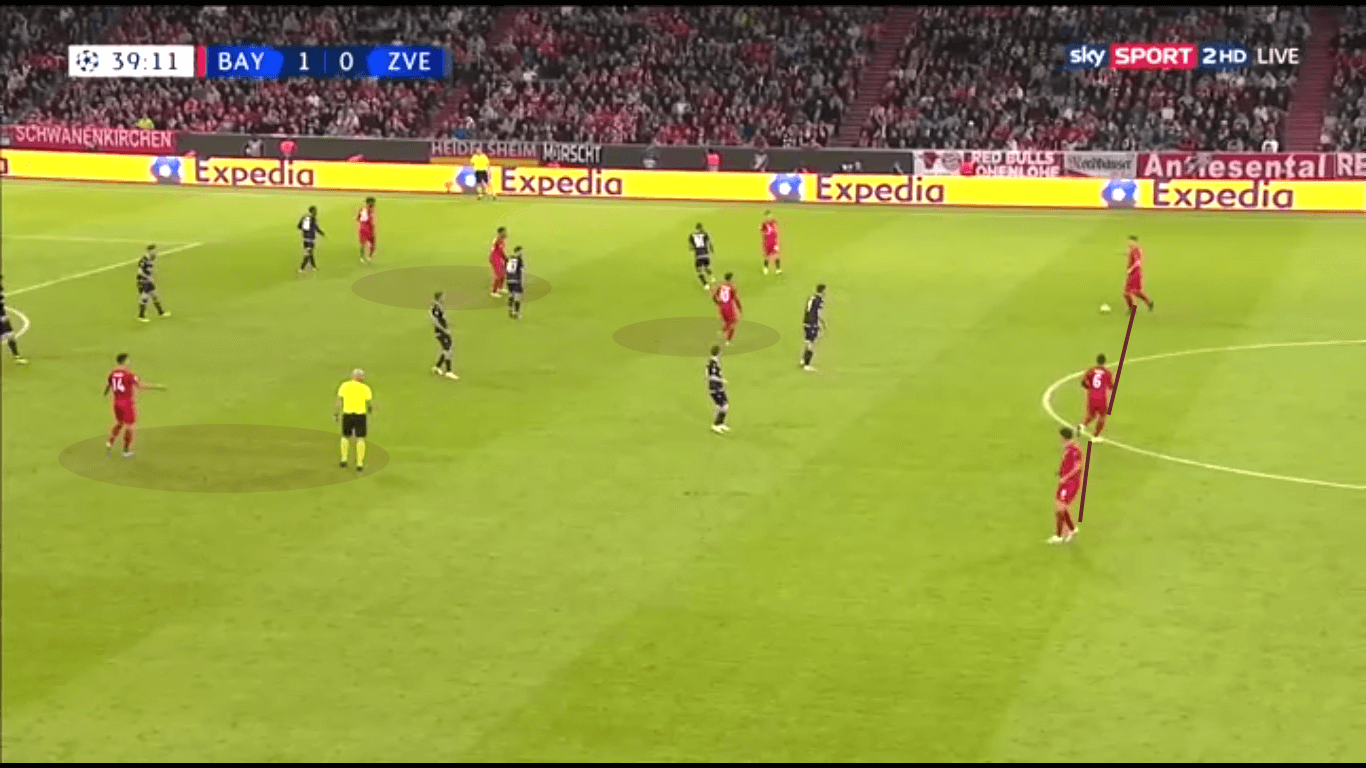
Kovač’s boys at intervals successfully found the gaps in Zvezda’s structure and used them to fastly break through the dense block and create scoring chances, mostly shooting from the edge of the box out of those situations.
The wide players’ roles
The home team had more than one way to get better of their opponent but the most successful one was to position their wingers inwards with the full-backs occupying the flanks high up the pitch. Wide players had huge roles in confusing Red Star’s defenders and making spaces for each other next to the sidelines.
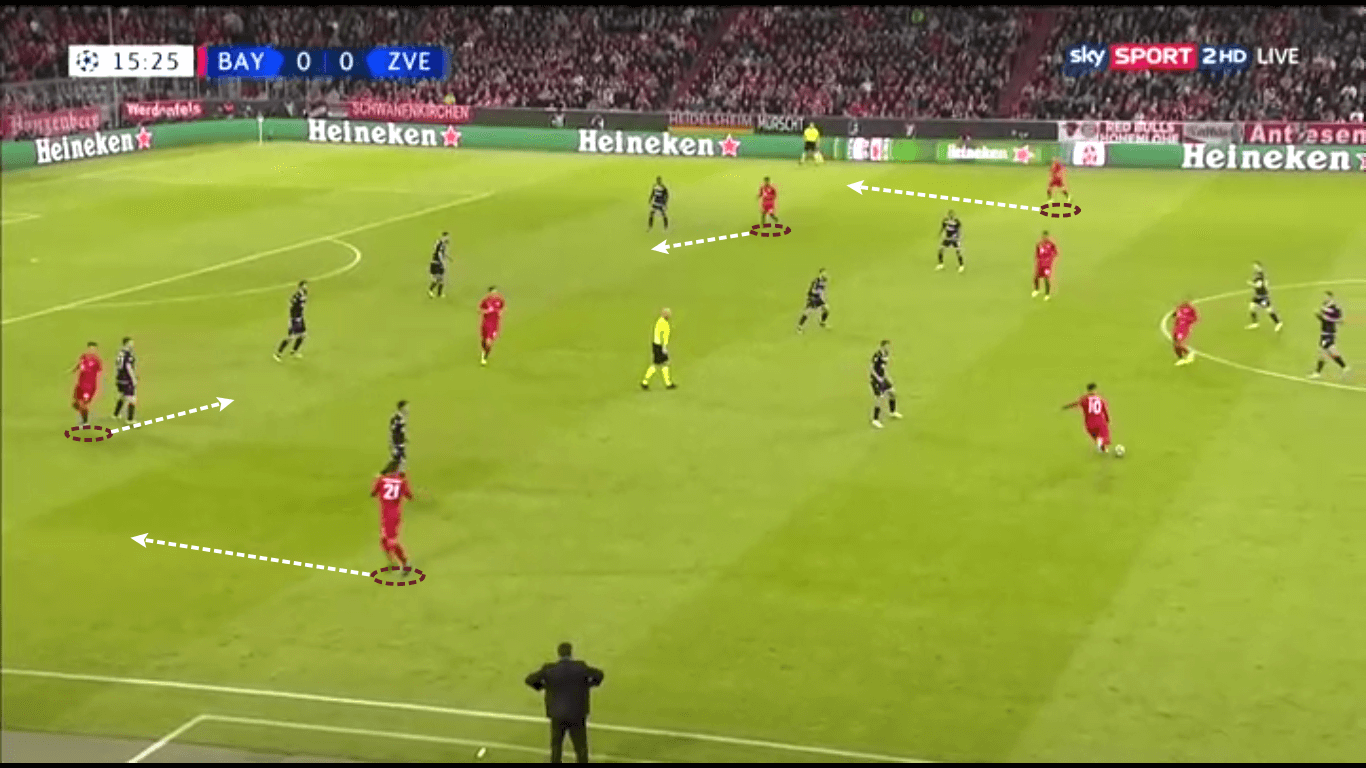
Coman and Perišić used to cut inside so they could provide support to Lewandowski and also be in the box for crosses and return-balls, while the chance creation was in hands of Lucas Hernandez and Joshua Kimmich. Full-backs often went with run-ins behind the opposition’s wide defenders’ backs, from where they searched for their team-mates that tracked the action to the end up.
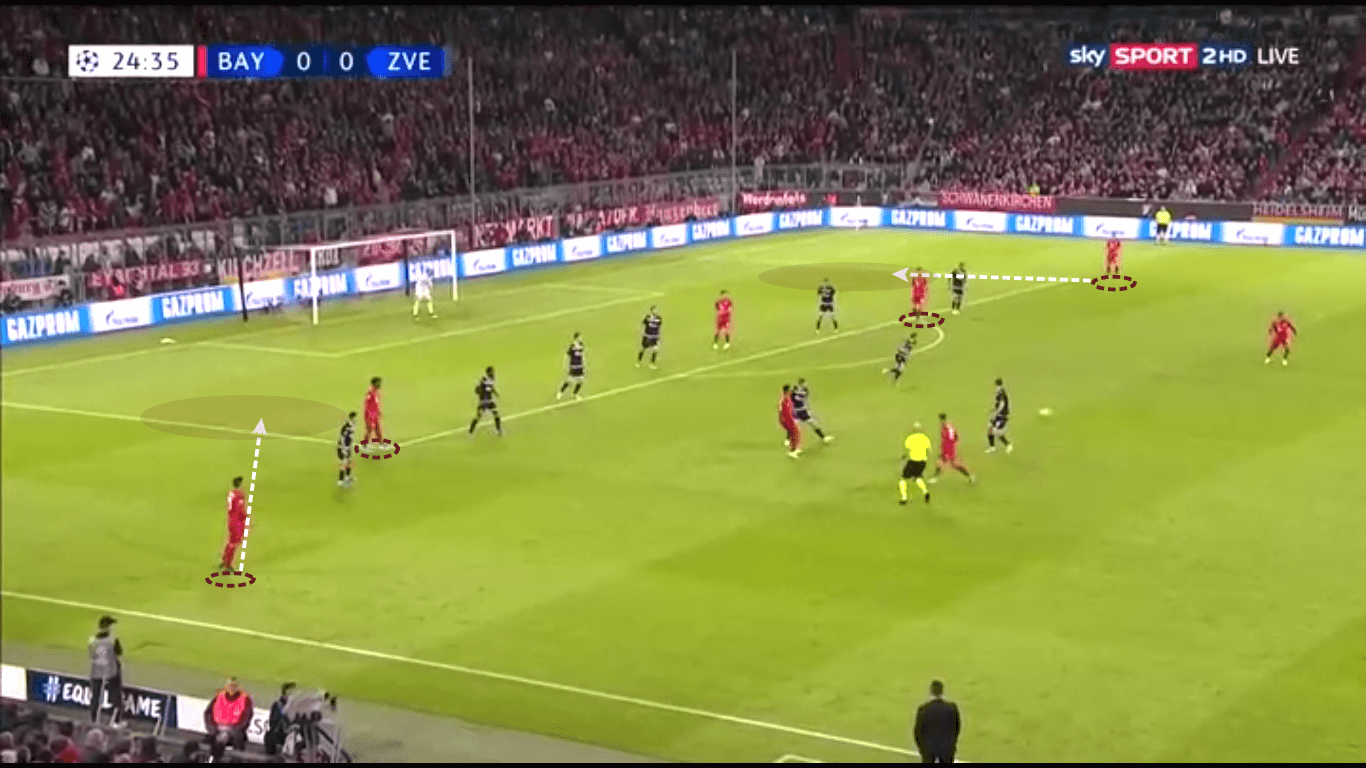
In the picture, we can see how Bayern Munich’s wingers are positioned at the edges of the box forcing the defence to stay narrower and being closer to their striker. The full-backs used the space that was left on the flanks for runs behind the Zvezda’s defensive line and supplied their offensive players with passes from those positions.
When Milojević’s team wasn’t positioned that low in the block, the home team tried to skip the play with the long balls also addressed to the sidelines where one of the wide defenders was positioned. Kimmich was a very important player once again because he provided width as much as he helped in the midfield, and was one of the main chance creators for the Germans.
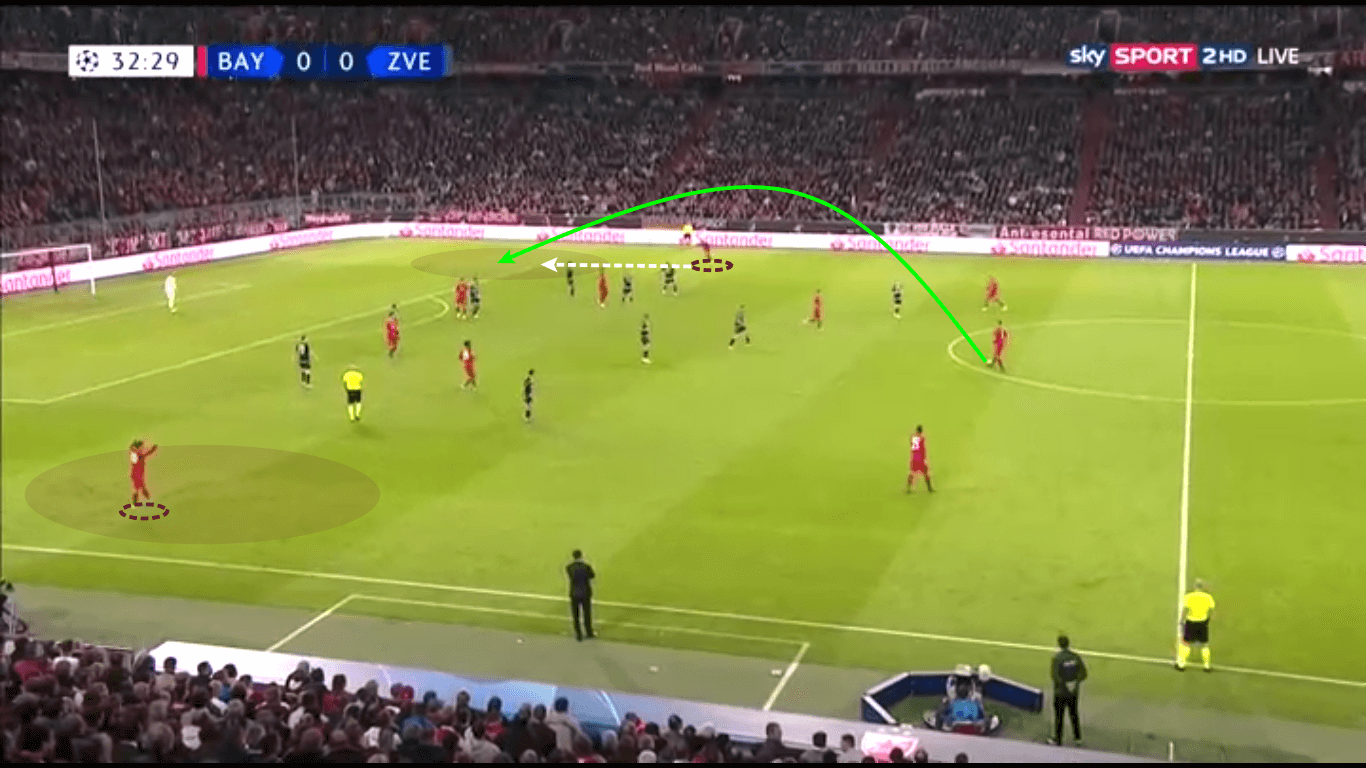
The same situation as the one shown above happened commonly with Hernandez on the left-hand side. The Frenchman had great communication with Perišić and they often created “2v1s” against Marko Gobeljić from which they often got out as winners and sent the balls into the box and created scenarios from which their team was the most dangerous.
Winning the half-space battle
Between-the-line play is surely one of the most important things in today’s football and Munich team managed to overpower the visitors in that segment of the game. The attacking side of their team was free in motions as they tended to find the gaps within Red Star’s defence and midfield from which they could get the balls to Lewandowski, or sent it to the players next to the flanks.
The space in inner corridors was tough to find for them due to the density of Milojević’s team’s block but the wingers and the striker of Bayern succeeded in exploiting those rooms with their good movements and communication. Lewandowski was frequently the one who pulled himself in the half-spaces, while the midfielders would go higher up the pitch to fill his empty spot at the edge of the box.
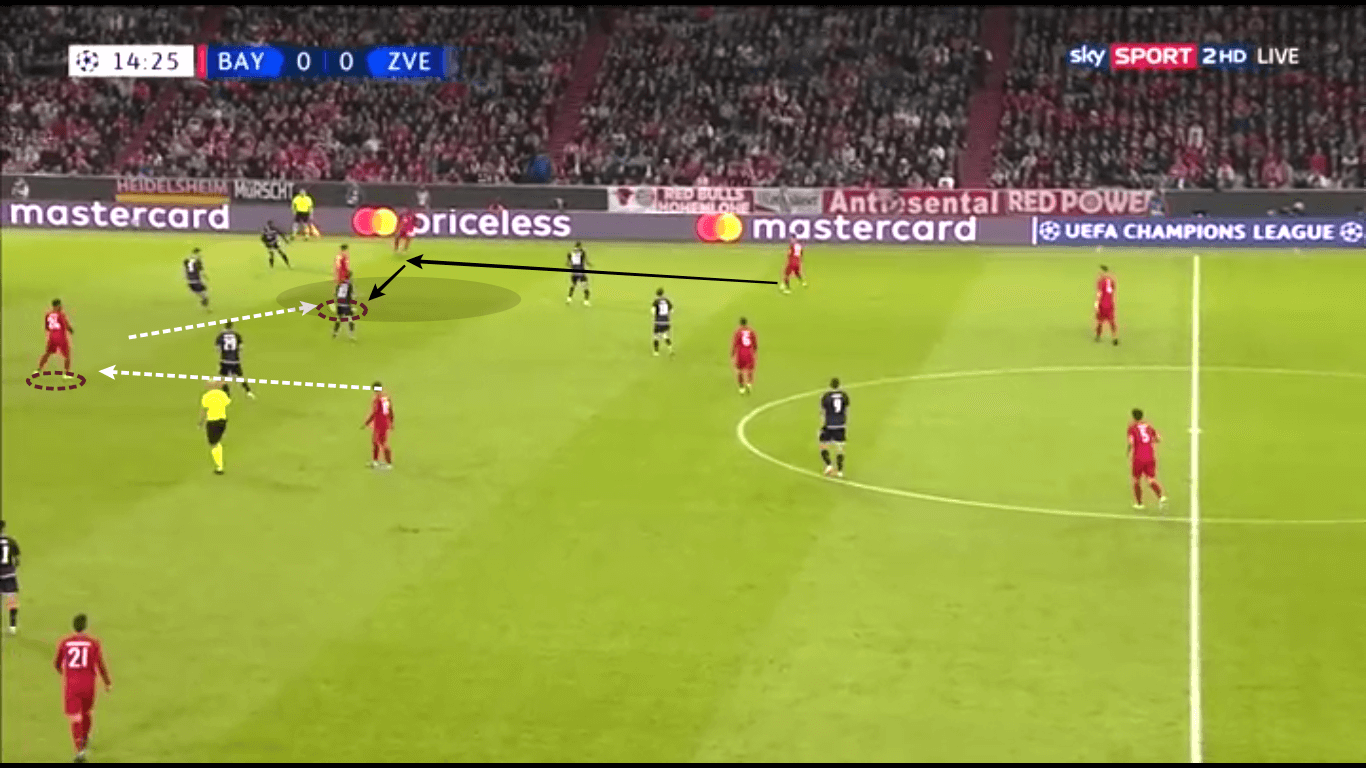
As we can see, Tolisso went out of his position so he could play as a false striker while the Pole was positioned closer to the right-handed flank providing the support to his team-mates in that zone of the pitch. Those overloads often created more room in the central areas of the pitch, so Bayern could play more directly through the middle.
After the home team got into the lead, Red Star opened themselves a little and opened the space for the hosts’ good transitional attacks. Once again, the wingers were the players trying to find the space in between and the Bavarians broke the opponent’s lines through them. Full-backs continued to overlap down the flanks offering their team-mates an extra option in the final third.
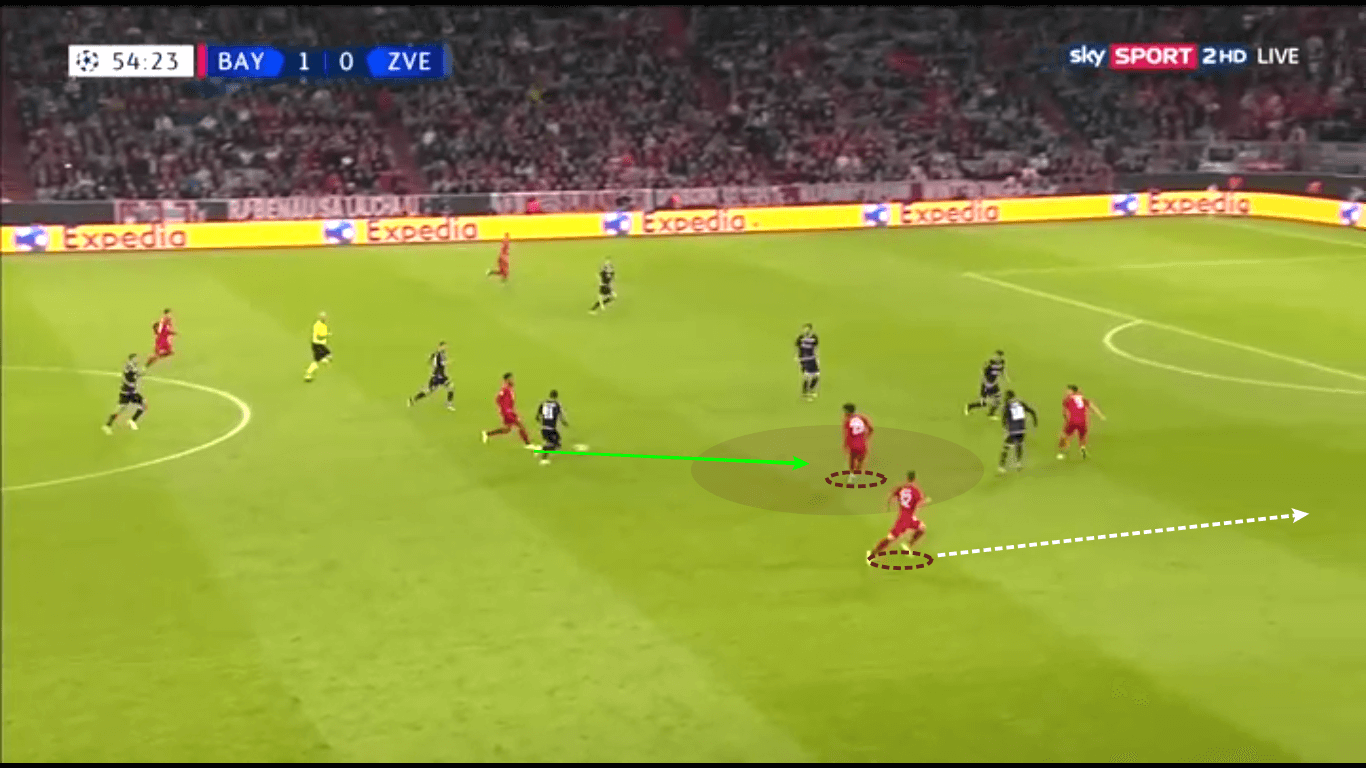
Coman and Kimmich communicated very well and their cooperation brought the German champion into a lot of chances, especially when the winger got balls in the half-space and the wide defender tracked the action and got the ball right from him. Coutinho was also the player who enabled a fast transformation for his side repeatedly positioning in the gaps and getting the ball moving fast-forward.
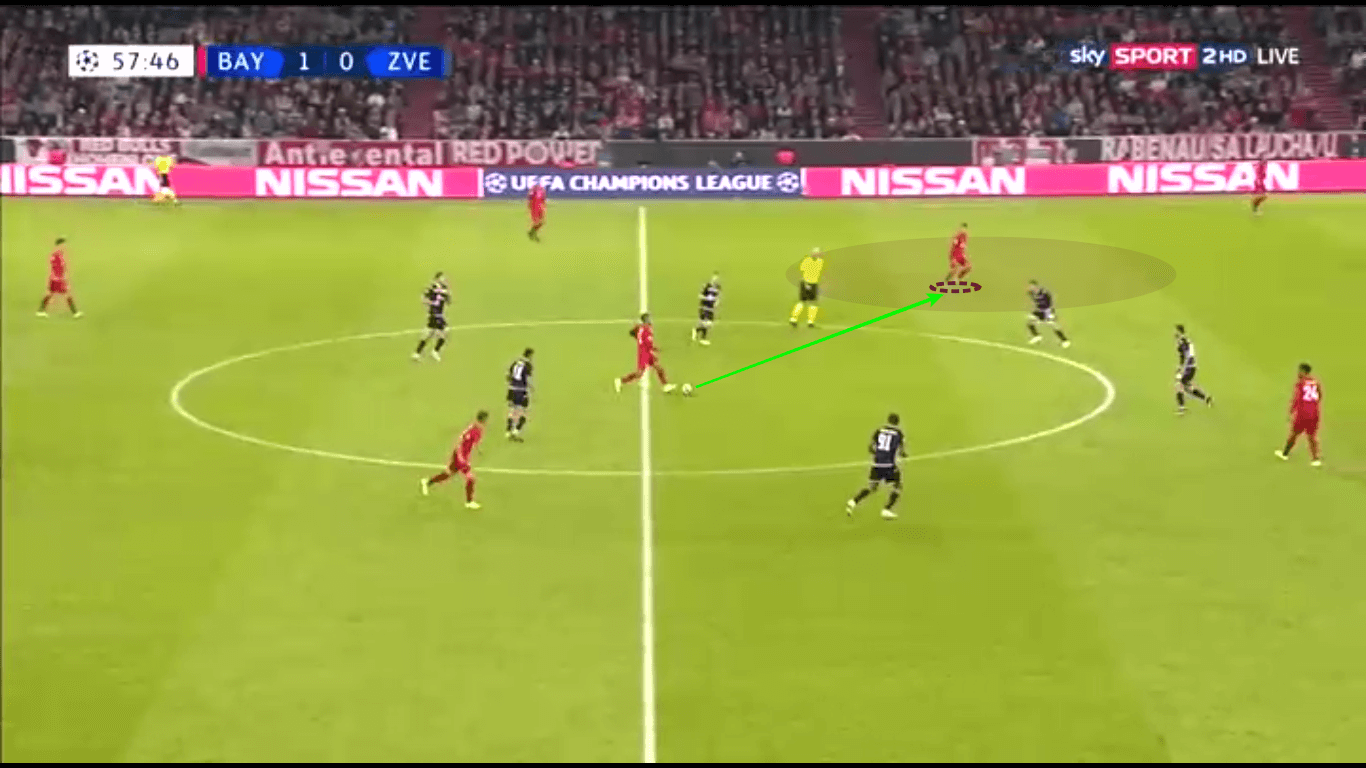
When he, or any other midfielder, got the ball in those situations they were looking for their striker who was locking down the opposition’s centre backs, and from those positions was cutting behind their backs into the box. Bayern’s midfield players frequently tried to supply him with passes between Red Star’s full-backs and centre-backs which brought them directly into the dangerous zones.
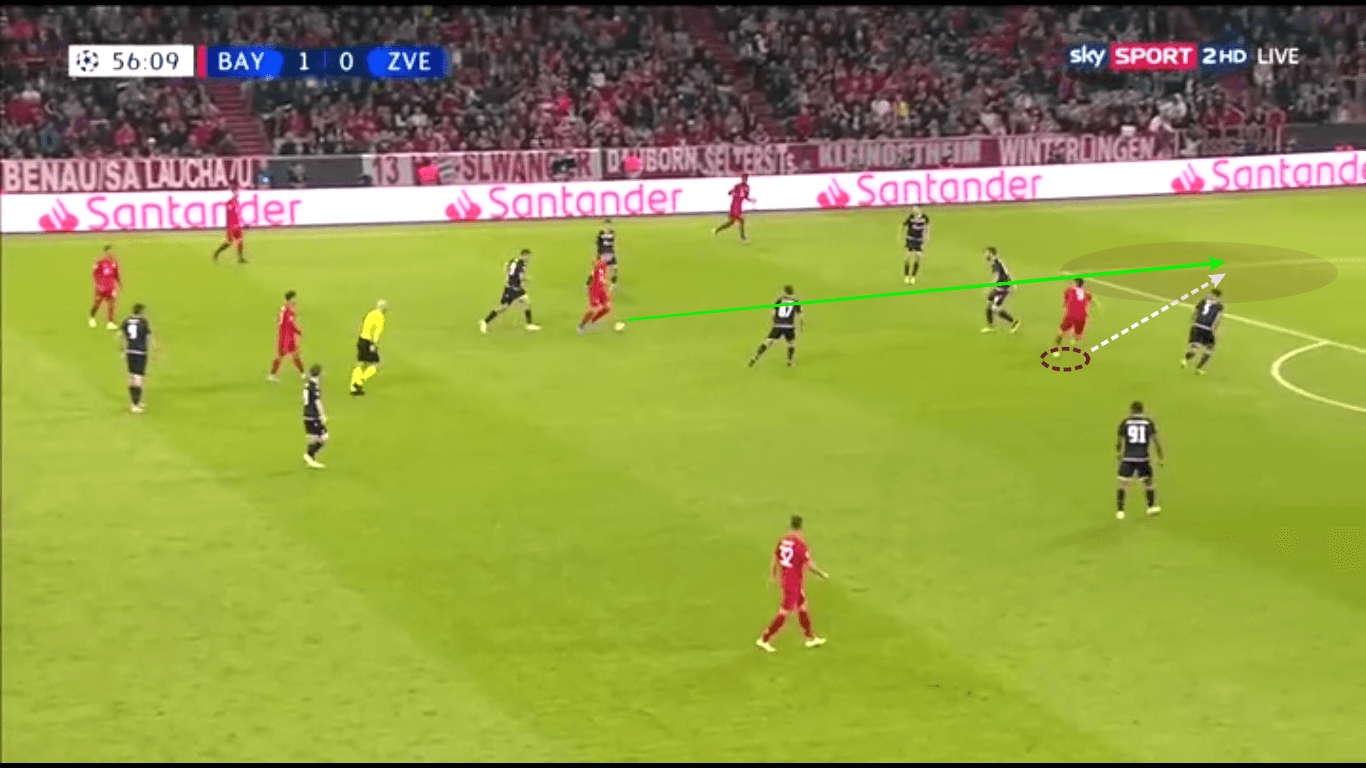
Kovač’s team got good use of the half-spaces and exploited them in a good manner, mostly in the second half when the opponents tried to open up a little bit. Attacking arsenal of their team was quite in the mood so they went into a lot of goal scoring opportunities with winning the battle in the central an inner corridors.
Conclusion
Bayern fully deserved the win in the opening match of this year’s UEFA Champions League. The individual class and technical superiority brought them to create a lot of chances, but they struggled with finishing so the result was “only” 3:0. As it was shown in the analysis, they overpowered Red Star in basically all of the game segments and got better of Milojević’s team due to well-prepared tactics for this game.
The Serbian champion defended tight right from the start, but that wasn’t enough for them to keep their non-beaten European streak continue, mostly due to the strength of their opponent’s in this matchup. They will still get their chances to shine, although they will need to get their offensive game to a higher level if they want to succeed at the elite level.

If you love tactical analysis, then you’ll love the digital magazines from totalfootballanalysis.com – a guaranteed 100+ pages of pure tactical analysis covering topics from the Premier League, Serie A, La Liga, Bundesliga and many, many more. Buy your copy of the August issue for just ₤4.99 here




Comments